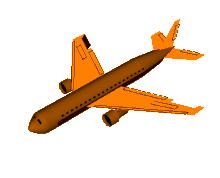Aileron
The ailerons, in the field of aeronautics, are command and control surfaces that are found at the ends of the wings of aircraft and their mission is to carry out the turns of the plane to both sides through a rolling motion.
These ailerons, along with the elevator, are controlled via the "horns" which is like the steering wheel of a car and which are named for their horn shape. In Airbus aircraft, these command and control surfaces (ailerons, elevator and rudder) are controlled via a vertical stick. To turn the aircraft, the pilot steps on the corresponding pedal at the same time that he turns the yoke or horn, thus achieving a coordinated movement and avoiding risky maneuvers.
In racing cars, a wing is arranged inverted with respect to aircraft in such a way that instead of pushing the vehicle up it pushes it down. The purpose of this is to increase the normal force that the floor exerts on the car; In this way, the friction between the tires and the track is increased and, consequently, the car's grip and traction increase, and consequently its final speed. In series production cars, Nissan is considered the inventor of this part, when in 1969 it created a plastic one for the 240Z model, from its Datsun subsidiary. A year later, this element first appeared on a European production model, the Opel Commodore A GS/E.
Principle of operation
The wing is designed with a straight face and a curved face, or with both curved faces but with one of them of greater development or length, so that the air that passes through the curve has to do it faster than the wind. of the straight face This, according to Bernoulli's principle, generates a pressure drop on the curved face and consequently a force due to suction. The idea behind bank is to cause lift asymmetry on both wings of the aircraft. This would induce one to ascend (gain lift) and the other to descend (lose lift). Deflecting the ailerons up or down achieves this effect.
Types of ailerons
In high subsonic flight aircraft, two different types of ailerons are used for in-flight longitudinal control: high-speed and low-speed. The reason for the differentiation comes from a basic application of physics: moments of force. The further away from the longitudinal axis the force is applied, the greater its intensity. Therefore, at very high speeds, the ailerons located at the tips of the wings are deactivated, which makes the movements of the aircraft smoother. When the speed is reduced enough, those of the tips are reactivated again to have an effective control of the entire wing surface.
Contenido relacionado
Technical help
Pneumocystography
Morse


